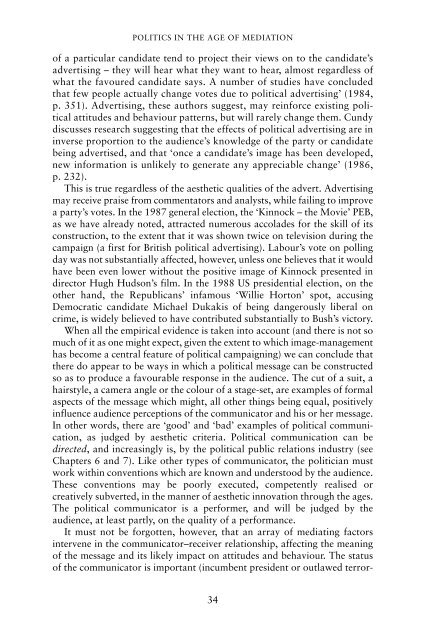20130412164339753295_book_an-introduction-to-political-communication
20130412164339753295_book_an-introduction-to-political-communication
20130412164339753295_book_an-introduction-to-political-communication
Create successful ePaper yourself
Turn your PDF publications into a flip-book with our unique Google optimized e-Paper software.
POLITICS IN THE AGE OF MEDIATION<br />
of a particular c<strong>an</strong>didate tend <strong>to</strong> project their views on <strong>to</strong> the c<strong>an</strong>didate’s<br />
advertising – they will hear what they w<strong>an</strong>t <strong>to</strong> hear, almost regardless of<br />
what the favoured c<strong>an</strong>didate says. A number of studies have concluded<br />
that few people actually ch<strong>an</strong>ge votes due <strong>to</strong> <strong>political</strong> advertising’ (1984,<br />
p. 351). Advertising, these authors suggest, may reinforce existing <strong>political</strong><br />
attitudes <strong>an</strong>d behaviour patterns, but will rarely ch<strong>an</strong>ge them. Cundy<br />
discusses research suggesting that the effects of <strong>political</strong> advertising are in<br />
inverse proportion <strong>to</strong> the audience’s knowledge of the party or c<strong>an</strong>didate<br />
being advertised, <strong>an</strong>d that ‘once a c<strong>an</strong>didate’s image has been developed,<br />
new information is unlikely <strong>to</strong> generate <strong>an</strong>y appreciable ch<strong>an</strong>ge’ (1986,<br />
p. 232).<br />
This is true regardless of the aesthetic qualities of the advert. Advertising<br />
may receive praise from commenta<strong>to</strong>rs <strong>an</strong>d <strong>an</strong>alysts, while failing <strong>to</strong> improve<br />
a party’s votes. In the 1987 general election, the ‘Kinnock – the Movie’ PEB,<br />
as we have already noted, attracted numerous accolades for the skill of its<br />
construction, <strong>to</strong> the extent that it was shown twice on television during the<br />
campaign (a first for British <strong>political</strong> advertising). Labour’s vote on polling<br />
day was not subst<strong>an</strong>tially affected, however, unless one believes that it would<br />
have been even lower without the positive image of Kinnock presented in<br />
direc<strong>to</strong>r Hugh Hudson’s film. In the 1988 US presidential election, on the<br />
other h<strong>an</strong>d, the Republic<strong>an</strong>s’ infamous ‘Willie Hor<strong>to</strong>n’ spot, accusing<br />
Democratic c<strong>an</strong>didate Michael Dukakis of being d<strong>an</strong>gerously liberal on<br />
crime, is widely believed <strong>to</strong> have contributed subst<strong>an</strong>tially <strong>to</strong> Bush’s vic<strong>to</strong>ry.<br />
When all the empirical evidence is taken in<strong>to</strong> account (<strong>an</strong>d there is not so<br />
much of it as one might expect, given the extent <strong>to</strong> which image-m<strong>an</strong>agement<br />
has become a central feature of <strong>political</strong> campaigning) we c<strong>an</strong> conclude that<br />
there do appear <strong>to</strong> be ways in which a <strong>political</strong> message c<strong>an</strong> be constructed<br />
so as <strong>to</strong> produce a favourable response in the audience. The cut of a suit, a<br />
hairstyle, a camera <strong>an</strong>gle or the colour of a stage-set, are examples of formal<br />
aspects of the message which might, all other things being equal, positively<br />
influence audience perceptions of the communica<strong>to</strong>r <strong>an</strong>d his or her message.<br />
In other words, there are ‘good’ <strong>an</strong>d ‘bad’ examples of <strong>political</strong> <strong>communication</strong>,<br />
as judged by aesthetic criteria. Political <strong>communication</strong> c<strong>an</strong> be<br />
directed, <strong>an</strong>d increasingly is, by the <strong>political</strong> public relations industry (see<br />
Chapters 6 <strong>an</strong>d 7). Like other types of communica<strong>to</strong>r, the politici<strong>an</strong> must<br />
work within conventions which are known <strong>an</strong>d unders<strong>to</strong>od by the audience.<br />
These conventions may be poorly executed, competently realised or<br />
creatively subverted, in the m<strong>an</strong>ner of aesthetic innovation through the ages.<br />
The <strong>political</strong> communica<strong>to</strong>r is a performer, <strong>an</strong>d will be judged by the<br />
audience, at least partly, on the quality of a perform<strong>an</strong>ce.<br />
It must not be forgotten, however, that <strong>an</strong> array of mediating fac<strong>to</strong>rs<br />
intervene in the communica<strong>to</strong>r–receiver relationship, affecting the me<strong>an</strong>ing<br />
of the message <strong>an</strong>d its likely impact on attitudes <strong>an</strong>d behaviour. The status<br />
of the communica<strong>to</strong>r is import<strong>an</strong>t (incumbent president or outlawed terror-<br />
34
















